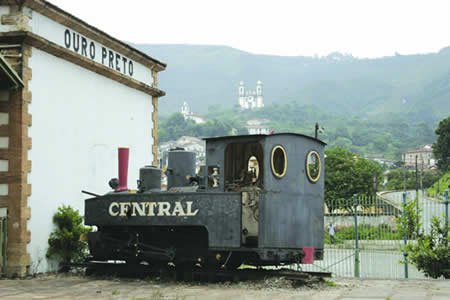Prisoners of war

Brigadier manufactured by Orestein & Koppel in 1918,
today on display at the Ouro Preto, MG train station
The Memória Ferroviária Project located six Brigadier-type steam engines that had arrived in Brazil as of 1917.
During the Battle of the Somme in France during World War I, the German Brigadier military engine conquered a special place in history. Between July and November 1916, it transported on a daily basis some 1,500 tons of supplies for German soldiers in the trenches — deliveries were made at night so the enemies could not see the tracks and trace the train cars. The wartime strategy was developed based upon a novel idea of French farmer Paul Decauville, who in 1875 built a rail line made up of portable and temporary modules for the transportation of his harvest of beets to storage facilities. This innovative rail line caught the attention of the imperial German army and was the basis for construction of a strategic rail system, adapted to follow soldiers in movement as well as to supply the front during any situation. From 1907 to 1919, German companies built some 2,750 Brigadier steam engines, also known as Brigade Lokomotiv Deustcher Feldbahn (DFB).
“The striking aspect of this locomotive is its flexible base containing four wheels on each side, a 0-8-0 wheel set, in which the forward and rear axles are attached with wide lateral clearance in order to maneuver on any size curve on the line,” said Sérgio Martire, one of the top steam engine specialists in Brazil and a consultant to the Memória Ferroviária Project. He reported that the Brigadier engines arrived in Brazil as of 1917 as “prisoners of war,” and three of them were sold to the City de Santos company for the transportation (using the Estrada de Ferro Santos/Jundiaí) of supplies from Cubatão Station to the water treatment system of the city of Santos.
According to Segundo Martire, the Memória Ferroviária Projeto has located six of these locomotives in Brazil, one of which he owns. “I searched for this engine for four years until finally finding one, displaying Prefix DFB 811 in a Santos scrap metal yard. Now it is in a good state of repair in the city of Sorocaba,” he said, adding that another Brigadier (Prefix DFB 915) was located in São Paulo, being displayed today at the Cubatão City Park.
Both were manufactured in 1916 by Henschel and belonged to the Berlin Battalion. Another three are in the state of Minas Gerais, one at the Ouro Preto railroad station, Prefix DFB 2684, built by Orestein & Koppel in 1918. “Probably, this machine was one of the many used in the mines located between the cities of Mariana and Ouro Preto, connecting the mine mouths to the gold milling and fixation systems,” he said.
Another engine in Minas is a 1919 Henschel, Prefix DFB 2574. Parked at the São João Del Rey Museum, it was used to ship limestone from the mines near the city of Tiradentes to a cement factory in Barroso (MG). This transportation, over a 600-mm gauge track, continued until 1954. The third locomotive in Minas was found in Lagoas, said Martire.
In Resende (RJ), the only Brigadier belonging to the Brazilian Army is found at the Agulhas Negra Military Academy. The Southern Railroad Battalion acquired the engine in 1920. According to Martire, “Viação Férrea Rio Grande do Sul transformed the machine for use on a metric gauge track to work on railroad construction projects along the border between Brazil and Uruguay.”